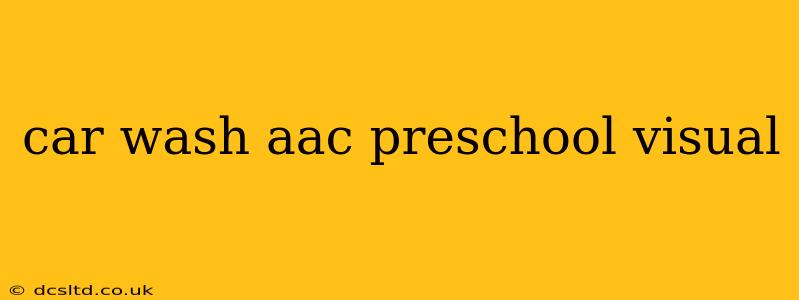Car Wash AAC Preschool Visuals: Engaging Communication for Young Learners
Using visual supports in early childhood education, especially for children who use Augmentative and Alternative Communication (AAC), is incredibly beneficial. This post explores the creation and use of car wash themed AAC visuals for preschoolers, focusing on how these visuals can enhance communication, learning, and engagement. We'll delve into various aspects of designing effective visuals and address frequently asked questions.
What are AAC visuals and why are they important for preschoolers?
Augmentative and Alternative Communication (AAC) visuals are tools that help children communicate their wants, needs, and ideas. For preschoolers, especially those with speech delays or communication challenges, these visuals are crucial. They provide a bridge to overcome communication barriers, fostering independence and participation in classroom activities. A car wash theme, specifically, can be highly motivating and engaging for young children.
How can I create a car wash themed AAC visual for a preschooler?
Creating effective car wash themed visuals involves a few key considerations:
-
Simplicity: Keep the images clear, simple, and uncluttered. Avoid using overly complex or busy backgrounds. Young children respond best to easily recognizable images. A single, high-quality photograph or drawing of a car going through a car wash is ideal.
-
Size and Format: Make the visuals large enough to be easily seen and manipulated. Consider laminating them for durability. You can create individual cards, a board, or even a digital app depending on the child's needs and abilities.
-
Accessibility: Ensure the visuals are easily accessible to the child. This might involve placing them within reach on a communication board, using a binder with clear pockets, or designing an app that is easily navigated.
-
Matching Vocabulary: Pair the visual with the corresponding word(s) – "car wash," "soap," "rinse," "dry." Use clear, age-appropriate font.
-
Integration with Activities: Incorporate the visuals directly into your car wash themed learning activities. This will reinforce the connection between the image and the activity, improving comprehension and communication.
What kind of activities can I use with car wash AAC visuals?
The car wash theme provides ample opportunities for interactive learning:
-
Dramatic Play: Create a car wash center using toy cars, sponges, and buckets. The child can use the visuals to request specific items or actions, such as "soap," "water," or "dry."
-
Sequencing Activities: Use the visuals to create a sequence of steps involved in washing a car. This helps children understand cause and effect, and improve their narrative skills.
-
Vocabulary Building: Integrate the visuals into circle time or small group activities to introduce and reinforce car wash vocabulary.
-
Social Skills Practice: Use the visuals to encourage interactions with peers, such as requesting help or sharing items during the car wash activity.
What are some examples of car wash themed AAC visuals?
You can easily find car wash images online or create your own drawings. Some examples include:
- A picture of a car entering a car wash tunnel.
- A close-up image of soapy water and a sponge.
- A photo of a car drying.
- Symbols representing the steps in a car wash sequence.
How can I adapt car wash AAC visuals for different communication levels?
The level of complexity of the visuals should always align with the child's communication abilities. Begin with simple pictures of key vocabulary words. As the child's skills develop, you can introduce more complex visuals, such as photo sequences or more abstract symbols. For children who have difficulty with single words, consider using sentence strips or other multi-word communication systems.
By thoughtfully creating and implementing car wash themed AAC visuals, educators can foster communication, learning, and enjoyment in preschoolers. The engaging nature of this theme allows for creative and effective teaching strategies, ultimately promoting language development and social interaction. Remember to always adapt the visuals to the child's individual needs and abilities, celebrating their unique communication style.
